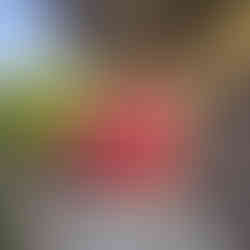
Bring out your favorite tropical drink to sip while we chat about this Type-A personality vine! It seems no tropical garden is complete without a splashy Bougainvillea. Available in most colors of the rainbow, this vine brings a long lasting statement into the garden. But the color does not come from the flower, as many people think. The flower is quite tiny (shown here), cream in color and tubular. All the color comes from the flower's bracts, which are actually modified leaves, similar to a Poinsettia's color.
One can travel anywhere in Southern California and spot Bougainvillea instantly. Its shear size makes a statement, and I have seen it used in many diverse ways, as heavy bowers on top of arbors, pergolas, and buildings, trained to cover walls and fences, in some places grown as a hedge (with a lot of pruning and care), or climbing up an overwhelmed tree (they look stunning trained on palms). If left on its own without a supportive structure, it can take on a mound effect, which can be attractive if well maintained. If not, they can harbor rodents, collect debris, and become a nuisance. Still other cultivars have been bred as dwarfs, allowing their use as a ground cover or container plant. Between diverse uses, cultivars, and colors, Bougainvillea offers numerous options for designers.
When my family moved to my childhood home in Palo Alto, its front east-facing corner had a Bougainvillea. It sported huge canes and a few good-sized thorns. If it had not been pruned every year, the vine would have taken over the little one-story house. So, it was to our advantage that at the time, frost damage or even die back to the ground meant we would not feel guilty giving it a hard pruning each year. Eventually, it had to be taken out, as its root mass started to damage the undersized brick planter it was in.
Nowadays, Bougainvillea can be readily grown in Northern California, but it should still be protected from harsh winter winds or low-land frosts. There are two specimens at West Valley College that are quite large, one red, the other purple. They appear to be thriving with little to no irrigation, telling us of their hardiness. As frost becomes less threatening in the Bay Area, we can expect to see more Bougainvilleas in the landscape.
A quick word about its name. Bougainvillea has no common name that I know of...at least, not one adopted by the International Code of Botanical Nomenclature. For this reason, we formally note (below) that it has "no common name." That said, we know to call it bougainvillea (see what I did there? Not capitalized or in italics), because we have collectively accepted its name as its common name, at least locally. Similar to magnolias. Still, I cannot help but feel that in its native regions of South America there are different common names bantered about the various communities and cultures throughout the continent. Should we bring one to the fore? For example, the University of Texas at El Paso references several, including pokok bunga kertas, or at the other end of the spectrum, Napoleón, to name just two. In the meantime, Bougainvillea remains, unless we want to talk about bougainvillea.
West Valley College Campus Location: Bougainvillea
Cilker (North garden)
Lat: 37°15'57.72"N
Long: 122° 0'40.27"W
facts
Botanical Name: Bougainvillea (may also be listed under B. spectabilis, but most available today are hybrids)
Bougainvillea: Honoree, admiral and explorer Louis-Antoine, Comte de Bougainville
Spectabilis: Spectacular, for its showiness
Common Name: No common name
Family Name: Nyctaginaceae
Origin: South America
design considerations
Positioning: Significant supportive structure, south facing walls, protected, embankments
Garden Themes: Mediterranean/dry, sub-tropical/tropical
Uses: Vine for arbor, trellis, wall, or other garden structures, container (dwarf cultivars)/bonsai, ground cover, mass, barrier, border, accent, standard (trained as small tree), slope protection
identifying characteristics
Type: Evergreen to semi-evergreen vine (deciduous in severe weather)
Form: Varies pending support, vining, mounding, upright, spreading to arching
Texture: Medium
Size: 30' high and spreading (dwarfs as little as 18")
Outstanding Feature(s): Flower (many available colors)
Stem: Dark gray when old, new growth is green with thorns (some cultivars, particularly dwarfs, may be thornless)
Leaf:
Type: Simple
Arrangement: Alternate
Shape: Deltoid, cordate to elliptic
Margin: Entire but wavy
Color: Medium to dark green (variegated cultivars are available)
Surface: Smooth, thin
Flower: Summer until frost. Bracts provide full range of colors including white and shades of yellow, orange, pink, red, and purple
Fruit: Autumn into winter. Five-lobed achene, but not common.
cultural requirements, tolerances & problems
Sunset Zones: 12-17, 19-24; H1, H2
USDA Zones: 9-10
Light: Full sun
WUCOLS SF Bay Area Hydro Zone: Low
Soil:
Texture: Sand, loam; well composted and well-drained
Moisture Retention: Accepts brief periods of dryness. Dislikes saturated soils
pH: Slightly acidic
Tolerances: Heat, coastal salt, drought, wind
Problems: Frost damage (plant in warmest, protected locations. Severe frost may dieback to ground); thorns
Branch Strength: N/A
Insects: Aphids, mealy bugs, spider mites, scale, white fly
Disease: Leaf spots, root rot, chlorosis
citations & attributions
Kobayashi, K.D., McConnell, J., Griffis, J. (2007). Bougainvillea. Cooperative Extension Services, College of Tropical Agriculture and Human Resources, University of Hawai'i at Mānoa. Accessed on July 23, 2021, from https://www.ctahr.hawaii.edu/oc/freepubs/pdf/of-38.pdf.
Norris Brenzel, K. (Ed.). (2012). The New Sunset Western Garden Book. New York: Time Home Entertainment, Inc.
NC State Extension. "Bougainvillea." North Carolina State University, Raleigh. Accessed on July 23, 2021, from https://plants.ces.ncsu.edu/plants/bougainvillea/.
Urban Forest Ecosystems Institute SelecTree. "Acer rubrum Tree Record." 1995-2021. Cal Poly State University, San Luis Obispo. Accessed on June 28, 2021. https://selectree.calpoly.edu/tree-detail/100.
UTEP. "Herbal Safety: Bougainvillea." University of Texas at El Paso. Accessed on July 23, 2021, from https://www.utep.edu/herbal-safety/herbal-facts/herbal%20facts%20sheet/bougainvillea%20.html.
Water Use Classification of Landscape Species. "WUCOLS IV Plant List." University of California, Division of Agriculture and Natural Resources, Davis. Accessed on June 28, 2021.
Photos:
All photos by TELCS.









Comments